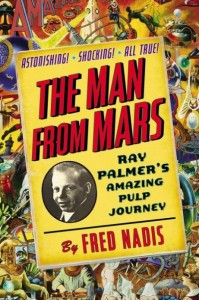War over Lemuria: Richard Shaver, Ray Palmer and the Strangest Chapter of 1940s Science Fiction, by Richard Toronto. Illustrated.
Jefferson, NC, McFarland & Co., April 2013, trade paperback $45.00 (vi + 256 pages), Kindle $16.19.
Now It Can Be Told!?
When I was a teenager in the 1950s, I read a lot of science fiction – novels and short-story collections by Isaac Asimov, Ray Bradbury, Arthur C. Clarke, Robert A. Heinlein, and many others. When I was in college in 1960, I discovered the Los Angeles Science Fantasy Society and s-f fandom. Many of the LASFS members had been s-f fans since the 1930s, and they told me about the history of s-f literature; personal information about the writers, the s-f magazines, and so on. Most of this was related casually, yet there was one subject that still stirred high emotions: editor Raymond A. Palmer and the major s-f magazine Amazing Stories from 1945 through 1949. Palmer (or RAP and Rap as he was known) claimed that his most lurid s-f yarns were not fiction but were based on fact! There really were dwarfs in underground caverns beaming evil rays at surface-dwelling humans that caused disease and wars. Most s-f fans felt that this was just a cynical ploy to increase his magazine’s circulation, which it did; but at the cost of giving all s-f fans a reputation among the general public as credulous simpletons who believed in flying saucers and that Buck Rogers and Flash Gordon were real people. Most s-f fans wrote thundering denunciations of RAP in their fanzines. The LASFS had sent a letter signed by all the club’s members to the publishers of Amazing Stories threatening to boycott the magazine if RAP was not replaced as editor. He finally was (actually, he resigned in 1949 when the publisher moved Amazing Stories’ editorial offices from Chicago to NYC), and went on to start his own minor magazines during the 1950s that were insignificant and largely ignored.
RAP and the s-f controversy of the late 1940s were never important beyond s-f circles, and are generally forgotten today – which makes it strange that two books about them have been published almost simultaneously: War over Lemuria: Richard Shaver, Ray Palmer and the Strangest Chapter of 1940s Science Fiction, by Richard Toronto in April, and The Man From Mars: Ray Palmer’s Amazing Pulp Journey, by Fred Nadis in June.
Both cover the subject in rich detail, and know it thoroughly. Both have interviewed Palmer’s closest associates still alive, and have gotten descriptions of RAP ranging from a charlatan and deliberate liar, to a misguided but true believer in what he was promoting. Both quote from and analyze RAP’s statements in his own autobiography, Martian Diary (in The Secret World, by Ray Palmer and Richard Shaver; Amherst, WI, Amherst Press, 1975). Toronto’s approach is slightly more scholarly, and his citations include his correspondence with the principals from the 1970s, showing his lifelong interest in the subject. Nadis’ book is more popularized; it is described in its blurb as “The rollicking true story of the legendary writer and editor who ruled over America’s fantasy and supernatural pulp journals in the mid-twentieth century, and shaped today’s UFO and sci-fi cultures: Ray Palmer.” Nadis apparently did not become interested in the subject until after RAP’s death, but he also interviewed RAP’s colleagues and his son, and studied RAP’s writings in s-f fan correspondence and fanzines of the 1930s in the collections of the Universities of California at Santa Barbara and Riverside, and numerous other universities and colleges that have extensive specialized holdings. Both books have pages of notes, bibliographies, and indexes.
Raymond A. Palmer (1910-1977) was easy to document because he became an active, enthusiastic s-f fan when he was 16 years old in 1926, and began corresponding with other young fans. RAP published some of the most widely-read s-f fanzines in the early 1930s, and his editorials, promotions of s-f, and thoughts are on record. During the 1930s he was a leading s-f fan, and was dubbed “the Son of Science Fiction”. When he became the editor of Amazing Stories for its new Ziff-Davis publishers in 1938, he was hailed as Fan Turns Professional – S-F Fan Makes Good. However, by the mid-1940s Palmer had told the fans that one of his main duties as editor was to increase the circulation of Amazing Stories, and that the “educated s-f fan community” was only a small percentage of the pulp adventure magazine’s readership.
In 1943, Amazing Stories got a long letter from a Richard S. Shaver, who claimed that he had found the alphabet of the lost civilization of Atlantis. Palmer’s assistant threw it in the wastebasket; Palmer fished it out and printed it. In correspondence, Palmer said that Shaver’s revelations were too dry for the magazine, and urged Shaver to rewrite them as adventure fiction. Shaver’s first story, heavily revised by Palmer, was “I Remember Lemuria” in the March 1945 issue. To quote Nadis, “After ‘I Remember Lemuria,’ more than twenty Shaver stories followed in the next four years. Shaver’s pay increased from one cent a word to one and a half cents, and then to two cents a word. But it is clear that many of his submissions underwent serious revisions. In June 1944, a half year after the Mantong alphabet letter had been published, and while the Ziff-Davis crew was still working over Shaver’s raw submissions, he wrote to Rap, ‘Naturally I am overjoyed that you can use my stories and am sorry that they must be rewritten – but believe me I know why – for I have been through much and it is work for me to write.’” (p. 89)
It was later learned that “Shaver had spent up to eight years in a catatonic state in the state hospital in Ypsilanti, Michigan” (Nadis, p. 82) As the Shaver stories progressed, RAP became more editorially emphatic that, while they might be fictionalized and dramatized, they were based upon prehistoric truth. The s-f fan community became more strident in demanding Palmer’s head. Fans who visited Amazing’s Chicago editorial offices while Shaver happened to be there reported that he seemed to be a sincere but harmless lunatic, while their kindest description of Palmer was that he was a flimflammer and hoaxer in the tradition of P.T. Barnum and 19th century medicine show barkers.
In June 1947, the first claim of a flying saucer sighting was made by Kenneth Arnold, a civilian pilot with no association with science fiction. Further claims of U.S. government cover-ups soon built up a public conspiracy theory that was much more widespread than what was called “the Shaver Mystery” in Amazing Stories ever was. In early July 1947 Palmer wrote to Arnold suggesting that they collaborate on an article or articles. In Spring 1948 Palmer started his own magazine, Fate, devoted to examining “unexplained mysteries”. When Ziff-Davis consolidated all its magazines in NYC in 1949, it was no hardship for Palmer to leave Amazing Stories and concentrate on his other interests, which focused increasingly on the occult such as the theories of Immanuel Velikovsky, Theosophy, and Hollow-Earthism. Since these bore no connection to science fiction, the wrath of the s-f community died away. In 1960 Julius Schwartz, a leading s-f fan of the 1930s and now an editor at DC Comics, named the secret identity of a new superhero, The Atom, Ray Palmer. RAP was not amused, partially because The Atom’s superpower was to shrink to miniature size, and the real Ray Palmer, because of a childhood almost-fatal accident, was a hunchbacked 4’8” dwarf.
Both books continue the biographies of RAP and Richard Shaver to their deaths. The two became close friends, and when the Palmers bought a large farm in rural Wisconsin, Palmer persuaded Shaver and his wife to come from Pennsylvania and become their neighbors. Shaver took to listening to rocks and painting surrealistic canvases of his visions. The art world didn’t care about his beliefs but liked his artistry. Shaver became despondent over being appreciated for what he felt was the wrong reasons. He allowed Palmer to publish his paintings as the covers on Palmer’s new magazines, edited from Palmer’s farmhouse. Shaver died in November 1975, and Palmer in August 1977.
I always felt that the story of Ray Palmer and the Shaver Mystery deserved a larger and more permanent documentation than the gossip of now-elderly s-f fans; and here it is. Buy where there is any interest in the history of s-f literature, of popular fiction during the 1940s, or of the beginnings of flying saucer cultdom.
The Man From Mars: Ray Palmer’s Amazing Pulp Journey, by Fred Nadis. Illustrated.
NYC, Jeremy P. Tarcher/Penguin, June 2013, hardcover $28.95 (xiii + 289 [+ 1] pages), Kindle $11.99.
The rollicking true story of the legendary writer and editor who ruled over America’s fantasy and supernatural pulp journals in the mid-twentieth century, and shaped today’s UFO and sci-fi cultures: Ray Palmer.
Meet Ray Palmer. A hustler, a trickster, and a visionary. The hunchbacked Palmer, who stood at just over four feet tall, was nevertheless an indomitable force, the ruler of his own bizarre sector of the universe. Armed with only his typewriter, Palmer changed the world as we know it – jumpstarting the flying saucer craze; frightening hundreds of thousands of Americans with “true” stories of evil denizens of inner earth; and reporting on cover-ups involving extraterrestrials, the paranormal, and secret government agencies.??As editor for the ground-breaking sci-fi magazine Amazing Stories and creator of publications such as Other Worlds, Imagination, Fate, Mystic, Search, Flying Saucers, Hidden World, and Space Age, Palmer pushed the limits and broke new ground in science fiction publishing in the 1940s and 1950s—and was reviled for it by purists who called him “the man who killed science fiction.”??In the first-ever biography devoted to the figure who molded modern geek culture, pulp scholar Fred Nadis paints a vivid portrait of Palmer—a brilliant, charming, and wildly willful iconoclast who helped ignite the UFO craze, convinced Americans of hidden worlds and government cover ups, and championed the occult and paranormal.??Palmer overcame serious physical handicaps to become the most significant editor during the “golden age” of pulp magazines; he rebelled in his own inimitable way against the bland suburban vision of the American Dream; he concocted new literary genres; and he molded our current conspiracy culture decades before The X-Files claimed that the truth was out there.
War over Lemuria: Richard Shaver, Ray Palmer and the Strangest Chapter of 1940s Science Fiction Paperback
McFarland, April 25, 2013
Shaverology: A Shaver Mystery Home Companion Paperback
Shavetron Press, August 29, 2013







